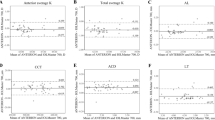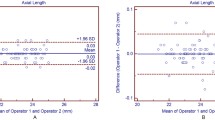Abstract
Aim
To assess the repeatability of a new optical biometer (OA-2000, Tomey, Japan) based on swept-source optical coherence tomography (SS-OCT) and Placido-disk topography in dry eyes with cataracts.
Method
A cross-sectional study was performed. Two hundred sixteen eyes of 216 cataract patients were enrolled in our hospital from March 2020 to December 2020. According to the subjective symptoms and objective examination of dry eye, the patients were assigned to dry eye group and non-dry eye group. Axial length (AL), keratometry readings (K), lens thickness (LT), anterior chamber depth (ACD), central corneal thickness (CCT) and white-to-white (WTW) distance were measured by one skilled operator. The repeatability of each parameter based on within-subject standard deviation (Sw), repeatability limit of standard deviation (2.77Sw), coefficient of variation (CoV) and intra-class correlation coefficient (ICC) was evaluated.
Result
There was no significant difference in age and gender between the two groups. NiaBUT and NifBUT in the dry eye group were significantly lower than those in the non-dry eye group (p < 0.05). The ICC mean values of AL, K1, K2, Km, ACD, LT and CCT were all greater than 0.960, except WTW. In the dry eye group, except CCT and WTW, the Sw scores for other biometric parameters were lower than 0.201, 2.77Sw scores were lower than 0.557, CoV(%) was less than 1%, and ICC mean values were greater than 0.964. Among them, the Sw scores for AL, LT and ACD were lower than 0.035, the 2.77Sw scores were lower than 0.097, and the ICC mean values are greater than 0.990.
Conclusion
The ocular biological parameters measured by SS-OCT have good repeatability for age-related cataract patients with dry eyes, in which the AL, LT and ACD are the highest repeatable. However, more attention should be paid for WTW in clinical application since repeatability influence.
Similar content being viewed by others
Data availability
All data generated or analyzed during this study are included in this published article.
References
Jee D, Kang S, Huang S et al (2020) Polygenetic-risk scores related to crystallin metabolism are associated with age-related cataract formation and interact with hyperglycemia, hypertension, western-style diet, and na intake. Nutrients 12(11):3534. https://doi.org/10.3390/nu12113534
Brian G, Taylor H. Cataract blindness--challenges for the 21st century. Bull World Health Organ. 2001;79(3):249-256
Wang W, Miao Y, Savini G et al (2017) Precision of a new ocular biometer in eyes with cataract using swept source optical coherence tomography combined with Placido-disk corneal topography. Sci Rep 7(1):13736. https://doi.org/10.1038/s41598-017-13800-7
Craig JP, Nichols KK, Akpek EK et al (2017) TFOS DEWS II definition and classification report. Ocul Surf 15(3):276–283. https://doi.org/10.1016/j.jtos.2017.05.008
Baudouin C, Aragona P, Messmer EM et al (2013) Role of hyperosmolarity in the pathogenesis and management of dry eye disease: proceedings of the OCEAN group meeting. Ocul Surf 11(4):246–258. https://doi.org/10.1016/j.jtos.2013.07.003
Epitropoulos AT, Matossian C, Berdy GJ et al (2015) Effect of tear osmolarity on repeatability of keratometry for cataract surgery planning. J Cataract Refract Surg 41(8):1672–1677. https://doi.org/10.1016/j.jcrs.2015.01.016
Gupta PK, Drinkwater OJ, VanDusen KW et al (2018) Prevalence of ocular surface dysfunction in patients presenting for cataract surgery evaluation. J Cataract Refract Surg 44(9):1090–1096. https://doi.org/10.1016/j.jcrs.2018.06.026
Huang J, Savini G, Hoffer KJ et al (2017) Repeatability and interobserver reproducibility of a new optical biometer based on swept-source optical coherence tomography and comparison with IOLMaster. Br J Ophthalmol 101(4):493–498. https://doi.org/10.1136/bjophthalmol-2016-308352
Liu B, Liao X, Lan CJ et al (2021) Repeatability of OA-2000 in ocular biometrics measurements and the AL detection rate in cataract eyes. Int Eye Sci 21(1):152–155. https://doi.org/10.3980/j.issn.1672-5123.2021.1.31
Hua Y, Qiu W, Xiao Q, et al Precision (repeatability and reproducibility) of ocular parameters obtained by the Tomey OA 2000 biometer compared to the IOLMaster in healthy eyes. PLoS One. 2018 Feb 27; 13(2):e0193023. doi: https://doi.org/10.1371/journal.pone.0193023
Shammas HJ, Hoffer KJ (2012) Repeatability and reproducibility of biometry and keratometry measurements using a noncontact optical low-coherence reflectometer and keratometer. Am J Ophthalmol 153(1):55-61.e2. https://doi.org/10.1016/j.ajo.2011.06.012
Wang XJ, Bao YZ (2017) Correlation between axial length and corneal curvature and spherical aberration. Zhonghua Yan Ke Za Zhi 53(4):255–259. https://doi.org/10.3760/cma.j.issn.0412-4081.2017.04.006
Montés-Micó R, Cáliz A, Alió JL (2004) Changes in ocular aberrations after instillation of artificial tears in dry-eye patients. J Cataract Refract Surg 30(8):1649–1652. https://doi.org/10.1016/j.jcrs.2004.02.041
Melles RB, Holladay JT, Chang WJ (2018) Accuracy of intraocular lens calculation formulas. Ophthalmology 125(2):169–178
Teshigawara T, Meguro A, Mizuki N (2020) Influence of pupil dilation on the Barrett universal II (new generation), Haigis (4th generation), and SRK/T (3rd generation) intraocular lens calculation formulas: a retrospective study. BMC Ophthalmol 20(1):299. https://doi.org/10.1186/s12886-020-01571-1
Liu B, Liao X, Lan CJ, et al. Repeatability and reproducibility of the biological parameters of healthy human eyes measured by sweptfrequency optical coherence tomography biometry. Chin J Exp Ophthalmol. 2019 11(37) doi:https://doi.org/10.3760/cma.j.issn.2095-0160.2019.11.013
Bjeloš Rončević M, Bušić M, Cima I et al (2011) Comparison of optical low-coherence reflectometry and applanation ultrasound biometry on intraocular lens power calculation. Graefes Arch Clin Exp Ophthalmol 249(1):69–75. https://doi.org/10.1007/s00417-010-1509-4
Huang J, Savini G, Wu F et al (2015) Repeatability and reproducibility of ocular biometry using a new noncontact optical low-coherence interferometer. J Cataract Refract Surg 41(10):2233–2241. https://doi.org/10.1016/j.jcrs.2015.10.062
Acknowledgements
Not applicable.
Funding
Not applicable.
Author information
Authors and Affiliations
Contributions
YF was involved in conception and design of the work and drafting the manuscriptYF CY, YL, JZJ and LJW contributed to data collection YF and WY were involved in supervision and statistical analysis YF, CY, YL, JZJ and LJW contributed to analysis and interpretation of the data; and All authors were involved in critical revision of the manuscript and approval of the final manuscript.
Corresponding author
Ethics declarations
Conflict of interests
All of the authors had no any personal, financial, commercial, or academic conflicts of interest separately.
Consent for publication
Not applicable.
Additional information
Publisher's Note
Springer Nature remains neutral with regard to jurisdictional claims in published maps and institutional affiliations.
Rights and permissions
About this article
Cite this article
Yang, F., Chang, Y., Yang, L. et al. Evaluation of the repeatability of optical coherence tomography in patients with age-related cataract associated with dry eye. Int Ophthalmol 43, 233–238 (2023). https://doi.org/10.1007/s10792-022-02421-3
Received:
Accepted:
Published:
Issue Date:
DOI: https://doi.org/10.1007/s10792-022-02421-3




